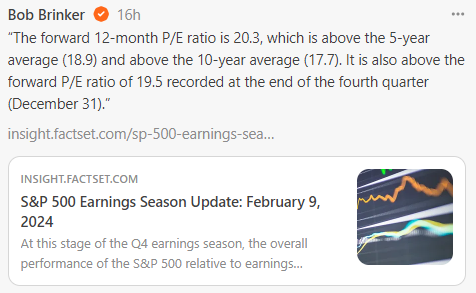JOB OPENINGS AND LABOR TURNOVER SURVEY (JOLTS)
Job openings were unchanged at 9.0 million in December. The number of job openings has declined from a high of 12.0 million in March 2022 and has been moving sideways around the current level since July 2023.
The quits rate, which measures the number of quits during the month as a percent of employment, held steady at 2.2%. The quits rate has decelerated from 3.0% in April 2022 to 2.2% today. This is a healthy level and indicates workers are confident in their ability to find a better job.
The January JOLTS report will be released on March 6th and will include annual revisions.
NONFARM PAYROLLS
Nonfarm payrolls increased 353,000 in January to a new record high. Jobs grew in several industries, including professional and business services (74,000), health care (70,000), retail trade (45,000), and social assistance (30,000). Average hourly earnings for all employees rose 0.6% in January, and is up 4.5% year-over-year. The average workweek for all employees decreased to 34.1 hours. Over the most recent three-month period, nonfarm payrolls increased at a healthy average pace of 289,333 per month.
UNEMPLOYMENT
The unemployment rate was unchanged in January at 3.7% and the number of unemployed persons was stable at 6.1 million. The labor force participation rate was 62.5% in January. The unemployment rate has fluctuated in a narrow range between 3.4% and 3.8% since February 2022. We think the unemployment rate is likely to drift higher in the coming months due to the FOMC’s monetary policy actions to slow the pace of growth. So far, the labor market has been very resilient in the face of monetary policy tightening.
The February jobs report is scheduled for release on Friday, March 8th.
ASA STAFFING INDEX
The ASA Staffing Index has declined roughly 12.5% year-over-year indicating that the labor market has weakened. The staffing data is often volatile during the December to January period due to weather and holiday staffing, so we must be patient to see what the early 2024 trends indicate. This indicator is among the weakest of all the labor data we monitor. Generally speaking, companies prefer to make adjustments to the temporary workforce before adjusting their permanent workforce. Therefore, this labor indicator can identify changes in the labor market earlier than others.
“Staffing employment is rising in line with seasonal patterns of expansion, but its momentum is lagging behind prior years due to accelerated economic headwinds within the broader labor market,” - Noah Yosif, chief economist at ASA.
NOTES
In case you missed it, we post occasional finance and economic updates on our Notes page at BrinkerAdvisor.com. You can read it anytime on our website by clicking on the ‘Notes’ tab near the top:








